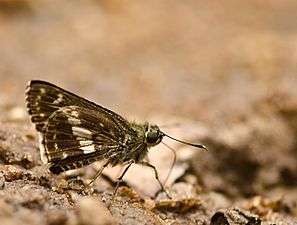Halpe porus
Halpe porus, or Moore's ace,[3][2] is a butterfly belonging to the family Hesperiidae, found in India.[3][4][1][3][2]
| Moore's ace | |
|---|---|
 | |
| Scientific classification | |
| Kingdom: | |
| Phylum: | |
| Class: | |
| Order: | |
| Family: | |
| Genus: | |
| Species: | H. porus |
| Binomial name | |
| Halpe porus (Mabille, 1876) | |
| Synonyms | |
Description
Male. Upperside blackish-brown. Forewing with seven semi-hyaline spots; two within the cell towards its end, one above the other, one a little larger close to the base of the first median interspace, and a similar spot obliquely above it, near the base of the second median interspace, three small sub-apical spots in an outwardly oblique curve. Hindwing with a small, slightly suffused space, slightly yellow-tinted in the upper middle of the wing, otherwise without markings. Cilia of forewing chequered brown and greyish-white, of hindwing greyish-white, with a few brown marks on it. Underside with the ground colour slightly paler, the spots as on the upperside and a series of small white sub-marginal spots in the interspaces, the series generally complete, but in some examples one or two of them are obsolescent. Hindwing with a conspicuous discal white outwardly curved band, divided by the veins into six elongated spots, commencing from near the costa before the apex, increasing in size hindwards, largest in the middle, and extending to near the submedian vein; a small whitish spot at the end of the cell, sometimes absent, and an incomplete series of sub-marginal whitish spots, the two nearest the anal angle larger than the others which are minute; the wing sparsely covered with minute yellowish scales. Antennae black, the shaft minutely spotted with white on the underside, the club pale orange-yellow on the underside and at the tip; palpi, head and body blackish-brown, palpi and pectus beneath with white and grey hairs; abdomen whitish beneath. Female like the male, but with an extra white spot on the forewing at the middle of the sub-median vein, and all the spots larger, the pale space in the middle of the hindwing somewhat paler.
The larvae feed on Bambusa striata and Ochlandra scriptoria.[5]
References
-

- Savela, Markku. "Halpe porus (Mabille, [1877])". Lepidoptera and Some Other Life Forms. Retrieved July 2, 2018.
- Varshney, R.K.; Smetacek, Peter (2015). A Synoptic Catalogue of the Butterflies of India. New Delhi: Butterfly Research Centre, Bhimtal & Indinov Publishing, New Delhi. p. 45. doi:10.13140/RG.2.1.3966.2164. ISBN 978-81-929826-4-9.
- Evans, W. H. (1949). A Catalogue of the Hesperiidae from Europe, Asia, and Australia in the British Museum. London: British Museum (Natural History). Department of Entomology. p. 257.
- Kalesh, S & S K Prakash (2007). "Additions of the larval host plants of butterflies of the Western Ghats, Kerala, Southern India (Rhopalocera, Lepidoptera): Part 1". Journal of the Bombay Natural History Society. 104 (2): 235–238.